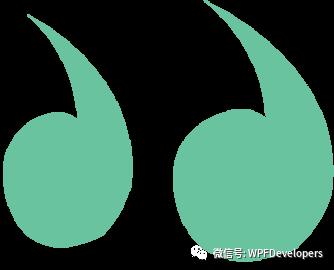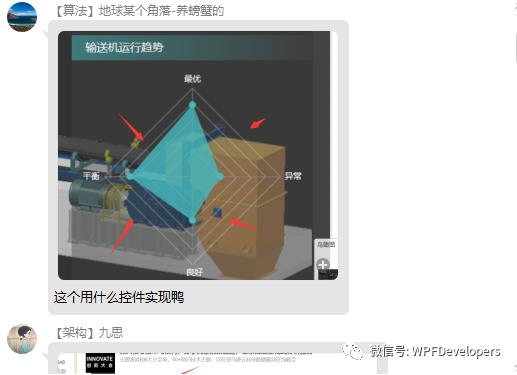WPF实现雷达图(仿英雄联盟)
Posted dotNET跨平台
tags:
篇首语:本文由小常识网(cha138.com)小编为大家整理,主要介绍了WPF实现雷达图(仿英雄联盟)相关的知识,希望对你有一定的参考价值。

WPF开发者QQ群: 340500857 | 微信群 -> 进入公众号主页 加入组织
转载


有小伙伴提出需要实现雷达图。
由于在WPF中没有现成的雷达图控件,所以我们自己实现一个。
PS:有更好的方式欢迎推荐。
01
—
代码如下
一、创建 RadarChart.cs 菜单继承 Control代码如下。

RadarChart.cs实现思路如下
1、RadarArray :存放展示集合 。
2、重写OnRender 。
3、根据三角函数和圆的半径计算出圆上的N个点绘制成多边形
GetPolygonPoint()。
4、在绘制多边形的时候因为需要多个大小不一的多边形,则需要
多次调用GetPolygonPoint()方法,最外层绘制150,中间层100
中心点层 50。
5、DrawPoints() 方法增加了一个bool参数isDrawText是否绘制Text文
本,因为最外侧需要绘制文本。
using System;
using System.Collections.Generic;
using System.Collections.ObjectModel;
using System.Globalization;
using System.Linq;
using System.Text;
using System.Windows;
using System.Windows.Controls;
using System.Windows.Media;
using System.Windows.Shapes;
namespace WPFDevelopers.Controls
{
public class RadarChart:Control
{
public ObservableCollection<RadarModel> RadarArray
{
get { return (ObservableCollection<RadarModel>)GetValue(RadarArrayProperty); }
set { SetValue(RadarArrayProperty, value); }
}
public static readonly DependencyProperty RadarArrayProperty =
DependencyProperty.Register("RadarArray", typeof(ObservableCollection<RadarModel>), typeof(RadarChart), new PropertyMetadata(null));
static RadarChart()
{
DefaultStyleKeyProperty.OverrideMetadata(typeof(RadarChart), new FrameworkPropertyMetadata(typeof(RadarChart)));
}
protected override void OnRender(DrawingContext drawingContext)
{
DrawPoints(150, drawingContext,true);
DrawPoints(100, drawingContext);
DrawPoints(50, drawingContext);
var myPen = new Pen
{
Thickness = 4,
Brush = Brushes.DodgerBlue
};
myPen.Freeze();
StreamGeometry streamGeometry = new StreamGeometry();
using (StreamGeometryContext geometryContext = streamGeometry.Open())
{
var h = this.ActualHeight / 2;
var w = this.ActualWidth / 2;
PointCollection points = new PointCollection();
foreach (var item in RadarArray)
{
var ss = new Point((item.PointValue.X - w) / 100 * item.ValueMax + w,(item.PointValue.Y - h) / 100 * item.ValueMax + h);
points.Add(ss);
}
geometryContext.BeginFigure(points[points.Count - 1], true, true);
geometryContext.PolyLineTo(points, true, true);
}
streamGeometry.Freeze();
SolidColorBrush rectBrush = new SolidColorBrush(Colors.LightSkyBlue);
rectBrush.Opacity = 0.5;
drawingContext.DrawGeometry(rectBrush, myPen, streamGeometry);
}
void DrawPoints(int circleRadius, DrawingContext drawingContext,bool isDrawText = false)
{
var myPen = new Pen
{
Thickness = 2,
Brush = Brushes.Gainsboro
};
myPen.Freeze();
StreamGeometry streamGeometry = new StreamGeometry();
using (StreamGeometryContext geometryContext = streamGeometry.Open())
{
var h = this.ActualHeight / 2;
var w = this.ActualWidth / 2;
PointCollection points = null;
if (isDrawText)
points = GetPolygonPoint(new Point(w, h), circleRadius, RadarArray.Count, drawingContext);
else
points = GetPolygonPoint(new Point(w, h), circleRadius, RadarArray.Count);
geometryContext.BeginFigure(points[points.Count - 1], true, true);
geometryContext.PolyLineTo(points, true, true);
}
streamGeometry.Freeze();
drawingContext.DrawGeometry(null, myPen, streamGeometry);
}
private PointCollection GetPolygonPoint(Point center, double r, int polygonBound, DrawingContext drawingContext = null)
{
double g = 18;
double perangle = 360 / polygonBound;
double pi = Math.PI;
List<Point> values = new List<Point>();
for (int i = 0; i < polygonBound; i++)
{
Point p2 = new Point(r * Math.Cos(g * pi / 180) + center.X, r * Math.Sin(g * pi / 180) + center.Y);
if(drawingContext != null)
{
FormattedText formattedText = new FormattedText(
RadarArray[i].Text,
CultureInfo.CurrentCulture,
FlowDirection.LeftToRight,
new Typeface(new FontFamily("Arial"), FontStyles.Normal, FontWeights.Thin, FontStretches.Normal),
20.001D, Brushes.Black)
{
MaxLineCount = 1,
TextAlignment = TextAlignment.Justify,
Trimming = TextTrimming.CharacterEllipsis
};
RadarArray[i].PointValue = p2;
if (p2.Y > center.Y && p2.X < center.X)
drawingContext.DrawText(formattedText, new Point(p2.X - formattedText.Width - 5, p2.Y - formattedText.Height / 2));
else if (p2.Y < center.Y && p2.X > center.X)
drawingContext.DrawText(formattedText, new Point(p2.X, p2.Y - formattedText.Height));
else if (p2.Y < center.Y && p2.X < center.X)
drawingContext.DrawText(formattedText, new Point(p2.X - formattedText.Width - 5, p2.Y - formattedText.Height));
else if (p2.Y < center.Y && p2.X == center.X)
drawingContext.DrawText(formattedText, new Point(p2.X - formattedText.Width, p2.Y - formattedText.Height));
else
drawingContext.DrawText(formattedText, new Point(p2.X, p2.Y));
}
values.Add(p2);
g += perangle;
}
PointCollection pcollect = new PointCollection(values);
return pcollect;
}
}
}二、创建RadarChartExample.xaml代码如下
<UserControl x:Class="WPFDevelopers.Samples.ExampleViews.RadarChartExample"
xmlns="http://schemas.microsoft.com/winfx/2006/xaml/presentation"
xmlns:x="http://schemas.microsoft.com/winfx/2006/xaml"
xmlns:mc="http://schemas.openxmlformats.org/markup-compatibility/2006"
xmlns:d="http://schemas.microsoft.com/expression/blend/2008"
xmlns:local="clr-namespace:WPFDevelopers.Samples.ExampleViews"
xmlns:wpfdev="https://github.com/yanjinhuagood/WPFDevelopers"
mc:Ignorable="d"
d:DesignHeight="450" d:DesignWidth="800">
<Grid Background="Gainsboro" >
<Border Background="White" Width="500" Height="500">
<Grid Margin="20,10">
<Grid.ColumnDefinitions>
<ColumnDefinition/>
<ColumnDefinition Width="40"/>
</Grid.ColumnDefinitions>
<Grid.RowDefinitions>
<RowDefinition Height="40"/>
<RowDefinition/>
</Grid.RowDefinitions>
<WrapPanel>
<Rectangle Width="6" Height="26" Fill="Black"/>
<TextBlock Text="能力图" FontWeight="Black" FontSize="24" Padding="10,0"/>
</WrapPanel>
<wpfdev:RadarChart Grid.Column="0" Grid.Row="1" RadarArray="{Binding RadarModels,RelativeSource={RelativeSource AncestorType=local:RadarChartExample}}"/>
</Grid>
</Border>
</Grid>
</UserControl>三、创建RadarChartExample.xaml.cs代码如下

ReadrChartExample.cs 思路如下
1、ValueMax 需要注意最小值0,最大值100。
using System.Collections.Generic;
using System.Collections.ObjectModel;
using System.Windows;
using System.Windows.Controls;
using WPFDevelopers.Controls;
namespace WPFDevelopers.Samples.ExampleViews
{
/// <summary>
/// RadarChartExample.xaml 的交互逻辑
/// </summary>
public partial class RadarChartExample : UserControl
{
public ObservableCollection<RadarModel> RadarModels
{
get { return (ObservableCollection<RadarModel>)GetValue(RadarModelsProperty); }
set { SetValue(RadarModelsProperty, value); }
}
public static readonly DependencyProperty RadarModelsProperty =
DependencyProperty.Register("RadarModels", typeof(ObservableCollection<RadarModel>), typeof(RadarChartExample), new PropertyMetadata(null));
List<ObservableCollection<RadarModel>> collectionList = new List<ObservableCollection<RadarModel>>();
public RadarChartExample()
{
InitializeComponent();
RadarModels = new ObservableCollection<RadarModel>();
var collection1 = new ObservableCollection<RadarModel>();
collection1.Add(new RadarModel { Text = "击杀", ValueMax = 95});
collection1.Add(new RadarModel { Text = "生存", ValueMax = 80 });
collection1.Add(new RadarModel { Text = "助攻", ValueMax = 70 });
collection1.Add(new RadarModel { Text = "物理", ValueMax = 80 });
collection1.Add(new RadarModel { Text = "魔法", ValueMax = 90 });
collection1.Add(new RadarModel { Text = "防御", ValueMax = 87 });
collection1.Add(new RadarModel { Text = "金钱", ValueMax = 59 });
var collection2 = new ObservableCollection<RadarModel>();
collection2.Add(new RadarModel { Text = "击杀", ValueMax = 59 });
collection2.Add(new RadarModel { Text = "生存", ValueMax = 80 });
collection2.Add(new RadarModel { Text = "助攻", ValueMax = 90 });
collection2.Add(new RadarModel { Text = "物理", ValueMax = 70 });
collection2.Add(new RadarModel { Text = "魔法", ValueMax = 80 });
collection2.Add(new RadarModel { Text = "防御", ValueMax = 90 });
collection2.Add(new RadarModel { Text = "金钱", ValueMax = 66 });
collectionList.AddRange(new[] { collection1, collection2 });
RadarModels = collectionList[0];
}
bool isRefresh = false;
private void Button_Click(object sender, RoutedEventArgs e)
{
if (!isRefresh)
RadarModels = collectionList[1];
else
RadarModels = collectionList[0];
isRefresh = !isRefresh;
}
}
}02
—
效果预览
数据来源于英雄联盟用户
数据1《屈越》
数据2《方拯》
源码地址如下
github:https://github.com/yanjinhuagood/WPFDevelopers.git
gitee:https://gitee.com/yanjinhua/WPFDevelopers.git
WPF开发者QQ群: 340500857
blogs: https://www.cnblogs.com/yanjinhua
Github:https://github.com/yanjinhuagood
出处:https://www.cnblogs.com/yanjinhua
版权:本作品采用「署名-非商业性使用-相同方式共享 4.0 国际」许可协议进行许可。
转载请著名作者 出处 https://github.com/yanjinhuagood

扫一扫关注我们,

更多知识早知道!

点击阅读原文可跳转至源代码
以上是关于WPF实现雷达图(仿英雄联盟)的主要内容,如果未能解决你的问题,请参考以下文章